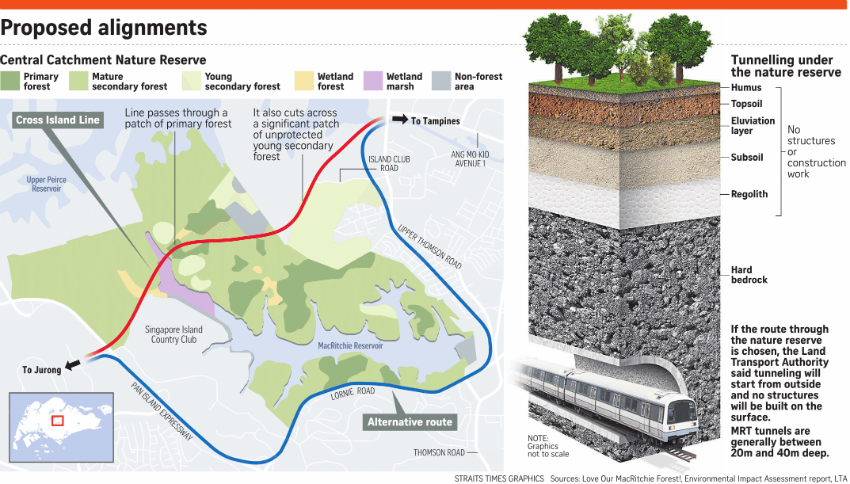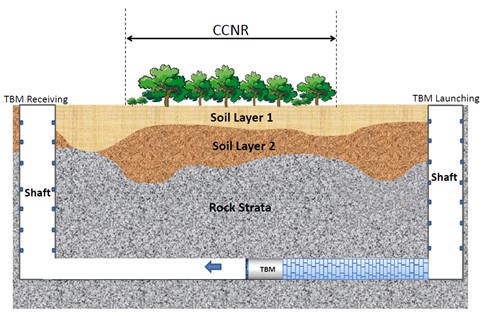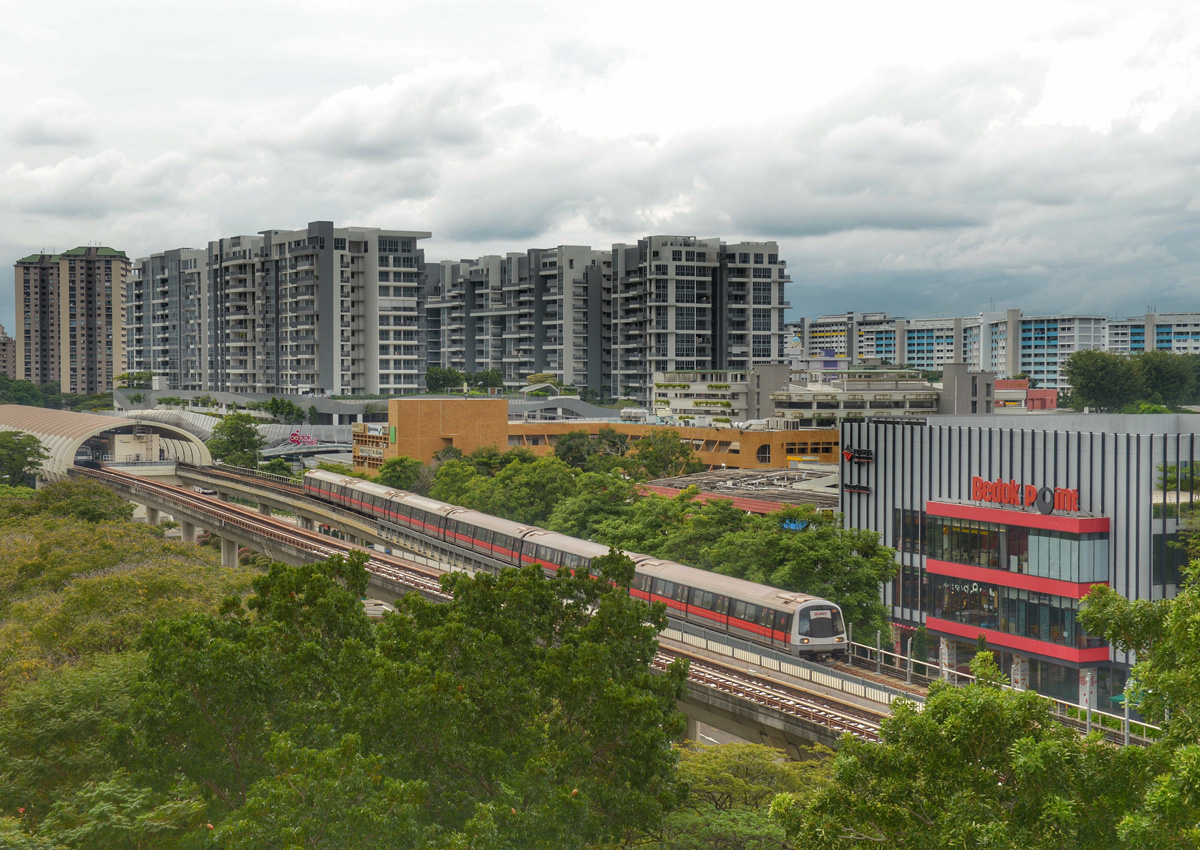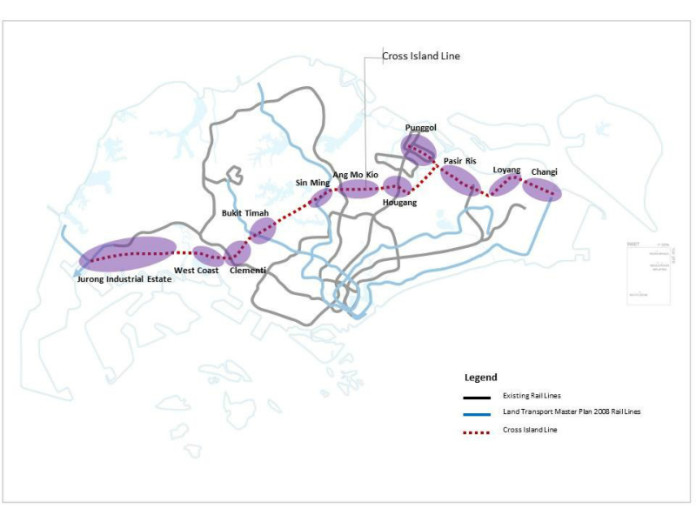Do we need the Cross Island Line? Can we do without it?
The Cross Island Line (CRL) will be an important part of our MRT network. It will provide a faster commute between the east and the west, from Changi to Jurong, stretching more than 50 km with about 30 stations. Nearly half of these stations will be interchange stations. Our preliminary estimate is that commuters from residential areas like Loyang, Pasir Ris, Hougang, Ang Mo Kio, Sin Ming, Bukit Timah, Clementi and West Coast will make at least 600,000 trips on the CRL every day. This will place the CRL higher, in terms of capacity and usage, compared to the North East Line. The CRL will also significantly enhance the resilience of our network, as the CRL will connect with all radial lines to provide commuters with many more travel routes to their destinations.
Why can’t the government just go with the alignment that does not cut through the CCNR?
To make an informed decision on the alignment option that best serves the public, the Government has to understand the total impact of both alignments, including on transport connectivity, engineering feasibility, the CCNR and the environment, as well as the nearby homes and families. It is for this reason that LTA is conducting an Environmental Impact Assessment (EIA) study, site investigation works, and an engineering feasibility study
The direct alignment is 4km long, with 2km of the tunnel running beneath the CCNR and the other 2km located outside it. As a shorter alignment, it will provide commuters faster East-West connectivity. The tunnels for the direct alignment will be about 40m deep and there will not be any construction of infrastructure on the surface within the CCNR. However, members of the public and nature groups have voiced concerns over the environmental impact of the direct alignment on the CCNR.
The skirting alignment, about 9km long, does not cross under the CCNR. However, the longer alignment will incur an additional travel time of six minutes for commuters crossing between the East and the West. It will also require longer tunnels and extra ventilation facilities. Besides land and home acquisitions that could affect families, the extra works could incur $2 billion more in expenditure.
What is an EIA? Is it a standard process as part of planning for all our MRT lines?
An Environmental Impact Assessment (EIA) evaluates the possible impact of a proposed project on the environment. The EIA on the two possible CRL alignments assesses the impact to the ecology, geology and hydrology of the Central Catchment Nature Reserve (CCNR).
Two years of planning, evaluation and consultation had been taken to develop the Phase 1 EIA report. An EIA of this scale is new for rail development and is necessary because the Government, too, cares about minimising the impact on the CCNR.
What is being done to mitigate the impact of site investigations?
Following extensive consultations with the nature groups for the first phase of the Environmental Impact Assessment, the site investigation to determine the geological properties of the ground, will adopt mitigating measures including reducing the number of boreholes within the gazetted boundary of the CCNR.
– First, only 16 boreholes will be drilled to extract vertical columns of soil samples, down from the earlier estimate of 72. These boreholes are 10cm in diameter and will be confined to public trails/existing clearings so as not to affect any vegetation. The drilling machines will also be modified to reduce the noise level and prevent spillage of slurry and fluid.
– Second, engineers will use non-intrusive geophysical survey methods.
– Imposing strict criteria to guide off-trail movements. The contractors will be supervised by NParks officers at all times.
– Avoiding ecologically sensitive areas such as streams, and swampy areas. For example, a 30m buffer zone is applied from these areas and no boreholes are allowed.
– All site investigation activities will also be restricted to daylight hours, so as not to affect nocturnal animals.
– With the mitigating measures, the number of machines and human movement within the reserve will be minimised.
Are the two proposed alignments for the Cross Island Line (CRL) running aboveground? Do you need to chop down any trees?
No. Both proposed options are underground and any tunnels beneath the CCNR will be located deep below the nature reserve at about 40m (equivalent to 12 storeys). There is no need to remove any vegetation for the site investigation works.
In addition, there will not be any construction work on the surface level within the gazetted boundary of CCNR. For both options, construction will be undertaken by tunnelling method using a Tunnel Boring Machine that starts from outside the nature reserve (see diagram below)
Similarly, the ventilation shafts or facility buildings will be sited outside the gazetted boundary of CCNR
Is the EIA report available online for public viewing? How can I give my views?
The first phase of the EIA report for the CRL is available on the LTA website for public viewing. Members of the public can email their views to LTA_CRL_CCNR_EIA@lta.gov.sg.
What was the consultation process like?
When LTA first announced the possible alignment of the CRL in 2013, nature groups raised concerns about the potential environmental impact on the CCNR. In response, LTA formed a working group, including representatives from NParks and nature groups, to serve as a discussion/consultation forum for the EIA study in the CCNR for the proposed Cross Island Line.
Since 2013, MOT, LTA and the nature groups have held many formal and informal meetings, including walkabouts in the CCNR with Senior Minister of State for Transport Josephine Teo.
Over the course of more than two years, LTA consulted the nature groups extensively in preparing for Phase 1 of the EIA report. For example, when studying the impact of the proposed site investigation works on the ecology and biodiversity of the CCNR, LTA’s EIA consultant took into consideration a study that the nature groups had done.
Separately, some residents living near the CCNR have expressed concern that the possible alignments may affect their homes. LTA has been engaging them by keeping them informed about the CRL study as well.
LTA will continue its engagement with stakeholders including the nature groups and residents in the area.







